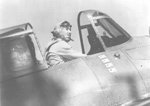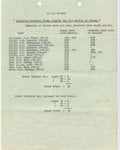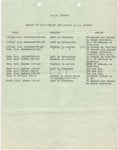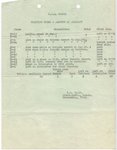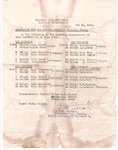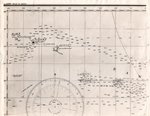- Thread starter
- #21
Lucky13
Forum Mascot
The shock from the submarine torpedoes and from Hammann's depth charges was severe. No . 3 auxiliary elevator carried away. Numerous fixtures on the overhead of the hangar crashed on to the hangar deck, and the landing gear of two planes on deck collapsed. All rivets in the starboard leg of the foremast sheared. The list was reduced to 17 degrees. Personnel were thrown in every direction, many sustaining minor injuries and broken bones. Since all destroyers had to be employed in searching for the attacking enemy submarines, and in rescuing Hammann survivors and Yorktown personnel who were thrown overboard by the explosion, no further salvage work could be attempted at that time. Accordingly, it was decided to postpone further attempts to salvage for the time being, to remove the salvage party to destroyers, and to return aboard Yorktown the following morning when the assistance of a large salvage tug was expected. Vireo was directed to come a! longside the starboard side, and all personnel then on board went down lines to the Vireo from which all except eight seriously wounded were transferred to destroyers for the night.
Prior to leaving Vireo, the Commanding Officer, Yorktown conducted burial services for two officers and one enlisted man from Hammann who had been picked up and brought to Vireo by destroyer boats.
About 0530 on the morning of June 7 the list of the Yorktown was noticed to be rapidly increasing to port and, at 0701, Yorktown turned over on her port side and sank in about 3000 fathoms of water with all battle flags flying. Her position at the time of sinking was Latitude 30°-46' North, Longitude 167°-24' West.
AIR
1. Organization of Yorktown Air Group:
Group Commander - Lt.Comdr. Oscar Pederson, USN.
VB-3 - 18 SBD's - Lt.Comdr. M.F. Leslie, USN.
*VF-3 - 25 F4F-4's - Lt.Comdr. J. Thach, USN.
VT-3 - 12 TBD's - Lt.Comdr. L.E. Massey, USN.
**VS-5 - 18 SBD's - Lieut. W.C. Short, USN
*VF-3 was composed of 16 VF-42 pilots and 11 VF-3 pilots.
**VS-5 was composed of 10 VB-5 pilots, plus 8 from the Saratoga group.
2. Attack Group.
(a) At about 1045 commenced launching the Attack Group composed of 17 VSB, 12 VTB and 6 VF. The torpedo planes were directed to proceed immediately towards the objective; and the VSBs ordered to circle overhead for 12 minutes and then proceed to overtake the VT before reaching the enemy. In order to conserve fuel for the VF, they were launched at 1105 with orders to rendezvous enroute. Due to the slow speed of the TBD's and the small fuel capacity of the F4F-4's, the above procedure was deemed expedient and worked out very well. At 1145 all three squadrons were rendezvoused and the group took the following formation: VT-3 at 1500 feet (just below the cloud base), 2 VF for low coverage at 2500 feet, 4 VF at 5000-6000 feet to protect the VT and low VF, and VB-3 at 16,000 feet. At about 1200, the enemy force was sighted bearing 345°, distance 30-40 miles, headed on an easterly course, speed about 20 knots. It consisted of 3 or 4 carriers, 2 BB's, 4 CA's, 1 or more CL's and many DD. The formation appeared scattered; apparently the CV's had just previously landed their planes on board after their attack on Midway Island. Insofar as could be seen, the enemy CV's appeared undamaged. At about 1220 VB-3 lost contact with the torpedo planes and was unable to communicate with them by radio. At 1225, the order to attack was given by VB-3. Enclosure (C) position of enemy CV's.
(b) Torpedo Attack.
The torpedo attack group consisted of 12 TBD's of VT-3, each armed with one MK 13 torpedo. VT-3 approached the enemy force on course 345° and when about 14 miles from the objective were attacked by Zero fighters. The squadron maneuvered to avoid the fighters and decreased altitude to 150 feet to avoid attacks from below. When about one mile to the Eastward of the target (enemy CV), the squadron commander turned towards the CV and commenced his attack. At this point he was shot down in flames by enemy VF, the remainder of the planes continued the attack. Only 5 VT dropped their torpedoes, as 7 were shot down during the approach and 3 more after the attack. The Fighter Squadron Commander stated that he saw 3 torpedo hits on the large CV to he Eastward and one on the small CV in the middle of the formation. It is estimated that the VT squadron was attacked by at least 8 Zero fighters and shot down at least one Zero fighter.
(c) Dive Bombing Attack.
The dive bombing attack group consisted of 17 SBD's of VB-3, each armed with 1-1000 pound bomb, fused with Mk 21 and 23 fuses. At about 1220, VB-3 was in position to attack the enemy CV, located to the North Eastward in the formation. The dive bombers commenced their approach from 14,500 feet out of the sun upon a large CV believed to be of the Akagi Class. Its flight deck was covered with planes spotted aft. Upon sighting our aircraft, the CV turned right to a Southerly course in order to launch planes. The sides of the carrier turned into a veritable ring of flame as the enemy commenced firing small caliber and anti-aircraft guns. There was no fighter opposition at altitude. The attack signal was executed and individual planes of VF-3 took interval for diving as the first enemy planes was being launched. Diving from the South, all pilots had a steady dive along the fore and aft line of the target. The first bomb exploded directly in the midst of the spotted planes, turning the after part of the flight deck into a sheet of flame. A fighter was blown over the side as it was being launched. Five direct hits and three very near misses were scored immediately thereafter. 3-B-14 and 3-B-15 upon seeing the carrier so heavily hit and burning furiously, shifted their dives to the light cruiser plane guard, scoring a near miss and hit on the fantail. 3-B-12 and 3-B-16 likewise shifted to a nearby battleship and scored a direct hit on the stern and a near miss.
Release altitudes averaged 2,500 feet and withdrawal was made to the Northeast with radical maneuvering at high speed close to the water amidst heavy anti-aircraft fire. On retirement, 3-B-8 reported being attacked by a twin-float bi-plane, possibly a Kawanishi 95 with no damage resulting.
The carrier was an inferno of flames and undoubtedly a total loss, the battleship was smoking from the stern, the light cruiser attacked was stopped and had settled slightly by the stern, but was not afire.
All Bombing Squadron Three aircraft returned undamaged to U.S.S. Yorktown by 1315. Two of our torpedo planes were also observed returning. At 1407 while in the landing circle the Yorktown directed over voice radio that all planes get clear as she was about to be attacked. As the squadron had broken up into sections for landing, section leaders took their sections Eastward into the area midway between Task Force 17 and Task Force 16 to await the completion of the attack. Jettisoned enemy bombs were observed falling well clear of surface vessels and several Japanese planes fell in flames.
When the attack on the Yorktown was completed, all section leaders took their sections over to Task Force 16 and landed aboard the U.S.S. Enterprise except for two planes which landed in the water due to lack of fuel. The pilots and rear seat men were rescued uninjured by a CA.
The CV attacked was described as being larger but narrower than the Yorktown and having a full length flight deck with a small island about 1/3 of the length aft of the bow. It had vertical smokestacks encased in one (similar to the Saratoga) on the starboard side adjoining the island. While proceeding towards the objective, four bombs were released prematurely when the gun and bomb electrical switches were turned on. This squadron reported also that the windshields and telescopes fogged up during the dive. This serious defect has been previously reported. It is estimated that VB-3 obtained at least 7 bomb hits which resulted in either the sinking or disablement of the CV as it was left dead in the water and completely aflame, and the damaging of 1 BB and CL.
(d) Fighter Escort Group.
The fighter escort group consisted of 6 F4F-4's of VF-3 squadron, their mission being to protect the torpedo planes' attack. Two VF were placed at 1000 feet above the torpedo planes and the other four VF 3000-4000 feet above them to furnish further protection. When about 4 miles from the Jap outer screen., which in turn was about 10- miles out from the CV's, two AA bursts were fired by a Jap ship. These bursts were used evidently to direct the enemy Combat Air Patrol to our planes, for almost immediately afterwards our VT and VF were attacked by about 18-20 Zero fighters. Our VF formed a line astern formation in order to stay together and give the leader an opportunity to turn and fire at the attacking planes. Soon after this the rear fighter was shot down. The formation twisted and turned to prevent the Zeros from getting on their tails and also to obtain firing position. During the engagement our remaining 3 VF were able to shoot down 5 Zeros. The Zeros concentrated most of their attacks on the rear plane, making beam and astern runs and pulling clear after each run.
The two VF planes directly over the torpedo planes were able to furnish considerable support to the VT during the first part of the approach when there were only 4 Zeros attacking. But later they were joined by 6 more Zeros, and the 2 VF were too heavily out-numbered to be of much help. They shot down one Zero and possibly another, and saw one Zero shot down by the TBD rear seat men. Soon thereafter, they became separated from each other and from the torpedo planes. One of these fighters was badly damaged and crash landed on board the Hornet. The 4 remaining planes of the escort group landed on board. They lost one pilot and two planes and shot down 6 and damaged two Zeros in the engagement.
Prior to leaving Vireo, the Commanding Officer, Yorktown conducted burial services for two officers and one enlisted man from Hammann who had been picked up and brought to Vireo by destroyer boats.
About 0530 on the morning of June 7 the list of the Yorktown was noticed to be rapidly increasing to port and, at 0701, Yorktown turned over on her port side and sank in about 3000 fathoms of water with all battle flags flying. Her position at the time of sinking was Latitude 30°-46' North, Longitude 167°-24' West.
AIR
1. Organization of Yorktown Air Group:
Group Commander - Lt.Comdr. Oscar Pederson, USN.
VB-3 - 18 SBD's - Lt.Comdr. M.F. Leslie, USN.
*VF-3 - 25 F4F-4's - Lt.Comdr. J. Thach, USN.
VT-3 - 12 TBD's - Lt.Comdr. L.E. Massey, USN.
**VS-5 - 18 SBD's - Lieut. W.C. Short, USN
*VF-3 was composed of 16 VF-42 pilots and 11 VF-3 pilots.
**VS-5 was composed of 10 VB-5 pilots, plus 8 from the Saratoga group.
2. Attack Group.
(a) At about 1045 commenced launching the Attack Group composed of 17 VSB, 12 VTB and 6 VF. The torpedo planes were directed to proceed immediately towards the objective; and the VSBs ordered to circle overhead for 12 minutes and then proceed to overtake the VT before reaching the enemy. In order to conserve fuel for the VF, they were launched at 1105 with orders to rendezvous enroute. Due to the slow speed of the TBD's and the small fuel capacity of the F4F-4's, the above procedure was deemed expedient and worked out very well. At 1145 all three squadrons were rendezvoused and the group took the following formation: VT-3 at 1500 feet (just below the cloud base), 2 VF for low coverage at 2500 feet, 4 VF at 5000-6000 feet to protect the VT and low VF, and VB-3 at 16,000 feet. At about 1200, the enemy force was sighted bearing 345°, distance 30-40 miles, headed on an easterly course, speed about 20 knots. It consisted of 3 or 4 carriers, 2 BB's, 4 CA's, 1 or more CL's and many DD. The formation appeared scattered; apparently the CV's had just previously landed their planes on board after their attack on Midway Island. Insofar as could be seen, the enemy CV's appeared undamaged. At about 1220 VB-3 lost contact with the torpedo planes and was unable to communicate with them by radio. At 1225, the order to attack was given by VB-3. Enclosure (C) position of enemy CV's.
(b) Torpedo Attack.
The torpedo attack group consisted of 12 TBD's of VT-3, each armed with one MK 13 torpedo. VT-3 approached the enemy force on course 345° and when about 14 miles from the objective were attacked by Zero fighters. The squadron maneuvered to avoid the fighters and decreased altitude to 150 feet to avoid attacks from below. When about one mile to the Eastward of the target (enemy CV), the squadron commander turned towards the CV and commenced his attack. At this point he was shot down in flames by enemy VF, the remainder of the planes continued the attack. Only 5 VT dropped their torpedoes, as 7 were shot down during the approach and 3 more after the attack. The Fighter Squadron Commander stated that he saw 3 torpedo hits on the large CV to he Eastward and one on the small CV in the middle of the formation. It is estimated that the VT squadron was attacked by at least 8 Zero fighters and shot down at least one Zero fighter.
(c) Dive Bombing Attack.
The dive bombing attack group consisted of 17 SBD's of VB-3, each armed with 1-1000 pound bomb, fused with Mk 21 and 23 fuses. At about 1220, VB-3 was in position to attack the enemy CV, located to the North Eastward in the formation. The dive bombers commenced their approach from 14,500 feet out of the sun upon a large CV believed to be of the Akagi Class. Its flight deck was covered with planes spotted aft. Upon sighting our aircraft, the CV turned right to a Southerly course in order to launch planes. The sides of the carrier turned into a veritable ring of flame as the enemy commenced firing small caliber and anti-aircraft guns. There was no fighter opposition at altitude. The attack signal was executed and individual planes of VF-3 took interval for diving as the first enemy planes was being launched. Diving from the South, all pilots had a steady dive along the fore and aft line of the target. The first bomb exploded directly in the midst of the spotted planes, turning the after part of the flight deck into a sheet of flame. A fighter was blown over the side as it was being launched. Five direct hits and three very near misses were scored immediately thereafter. 3-B-14 and 3-B-15 upon seeing the carrier so heavily hit and burning furiously, shifted their dives to the light cruiser plane guard, scoring a near miss and hit on the fantail. 3-B-12 and 3-B-16 likewise shifted to a nearby battleship and scored a direct hit on the stern and a near miss.
Release altitudes averaged 2,500 feet and withdrawal was made to the Northeast with radical maneuvering at high speed close to the water amidst heavy anti-aircraft fire. On retirement, 3-B-8 reported being attacked by a twin-float bi-plane, possibly a Kawanishi 95 with no damage resulting.
The carrier was an inferno of flames and undoubtedly a total loss, the battleship was smoking from the stern, the light cruiser attacked was stopped and had settled slightly by the stern, but was not afire.
All Bombing Squadron Three aircraft returned undamaged to U.S.S. Yorktown by 1315. Two of our torpedo planes were also observed returning. At 1407 while in the landing circle the Yorktown directed over voice radio that all planes get clear as she was about to be attacked. As the squadron had broken up into sections for landing, section leaders took their sections Eastward into the area midway between Task Force 17 and Task Force 16 to await the completion of the attack. Jettisoned enemy bombs were observed falling well clear of surface vessels and several Japanese planes fell in flames.
When the attack on the Yorktown was completed, all section leaders took their sections over to Task Force 16 and landed aboard the U.S.S. Enterprise except for two planes which landed in the water due to lack of fuel. The pilots and rear seat men were rescued uninjured by a CA.
The CV attacked was described as being larger but narrower than the Yorktown and having a full length flight deck with a small island about 1/3 of the length aft of the bow. It had vertical smokestacks encased in one (similar to the Saratoga) on the starboard side adjoining the island. While proceeding towards the objective, four bombs were released prematurely when the gun and bomb electrical switches were turned on. This squadron reported also that the windshields and telescopes fogged up during the dive. This serious defect has been previously reported. It is estimated that VB-3 obtained at least 7 bomb hits which resulted in either the sinking or disablement of the CV as it was left dead in the water and completely aflame, and the damaging of 1 BB and CL.
(d) Fighter Escort Group.
The fighter escort group consisted of 6 F4F-4's of VF-3 squadron, their mission being to protect the torpedo planes' attack. Two VF were placed at 1000 feet above the torpedo planes and the other four VF 3000-4000 feet above them to furnish further protection. When about 4 miles from the Jap outer screen., which in turn was about 10- miles out from the CV's, two AA bursts were fired by a Jap ship. These bursts were used evidently to direct the enemy Combat Air Patrol to our planes, for almost immediately afterwards our VT and VF were attacked by about 18-20 Zero fighters. Our VF formed a line astern formation in order to stay together and give the leader an opportunity to turn and fire at the attacking planes. Soon after this the rear fighter was shot down. The formation twisted and turned to prevent the Zeros from getting on their tails and also to obtain firing position. During the engagement our remaining 3 VF were able to shoot down 5 Zeros. The Zeros concentrated most of their attacks on the rear plane, making beam and astern runs and pulling clear after each run.
The two VF planes directly over the torpedo planes were able to furnish considerable support to the VT during the first part of the approach when there were only 4 Zeros attacking. But later they were joined by 6 more Zeros, and the 2 VF were too heavily out-numbered to be of much help. They shot down one Zero and possibly another, and saw one Zero shot down by the TBD rear seat men. Soon thereafter, they became separated from each other and from the torpedo planes. One of these fighters was badly damaged and crash landed on board the Hornet. The 4 remaining planes of the escort group landed on board. They lost one pilot and two planes and shot down 6 and damaged two Zeros in the engagement.

